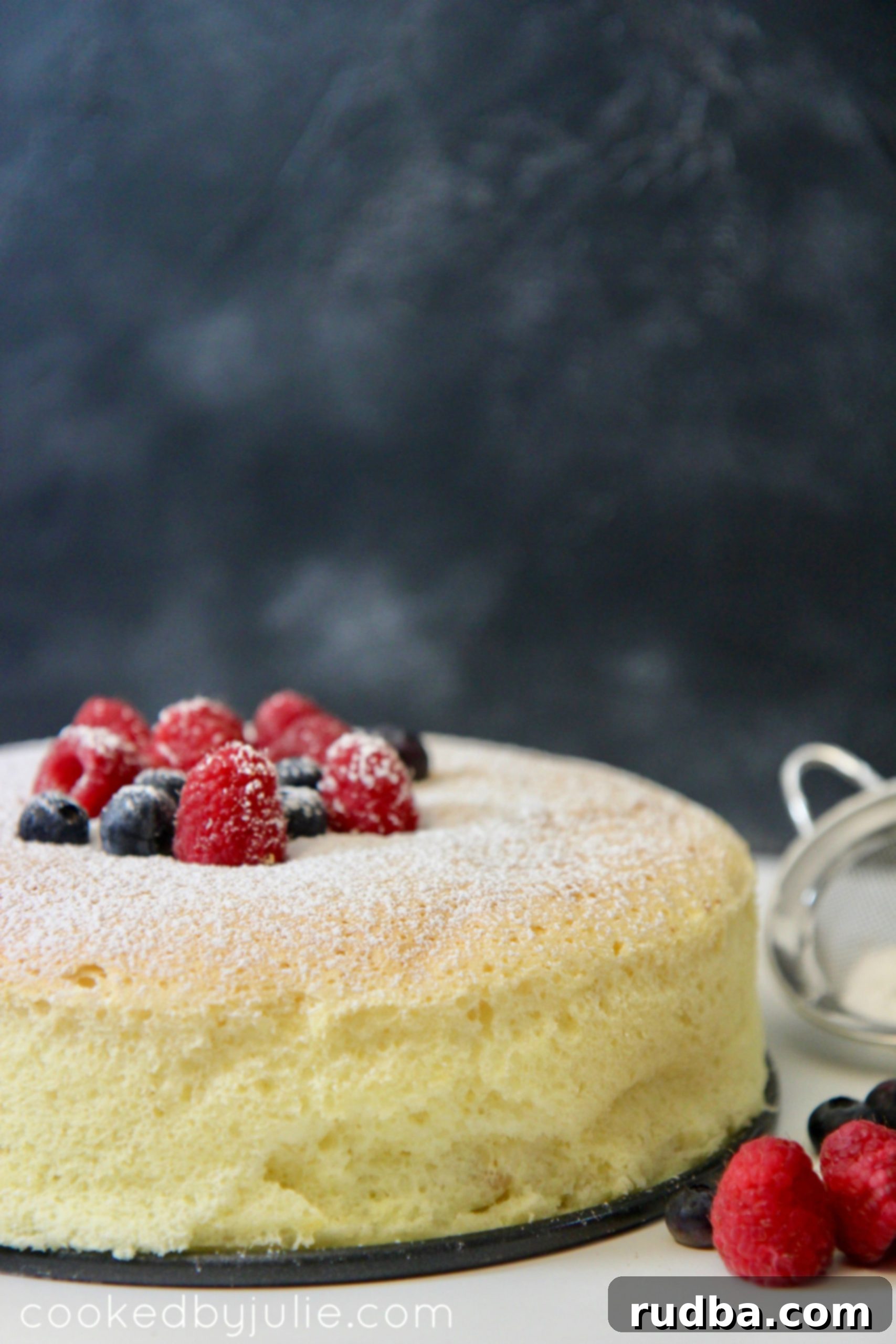The Ultimate Guide to Japanese Cotton Cheesecake: Achieve Unrivaled Fluffiness and Flavor
Prepare to embark on a culinary journey that will redefine your perception of cheesecake. The Japanese Cotton Cheesecake, also affectionately known as Soufflé Cheesecake or Cotton Soft Cheesecake, stands in a league of its own. Unlike its dense, rich Western counterparts, this marvel of baking is incredibly light, airy, and boasts an ethereal, melt-in-your-mouth texture that mimics the softness of cotton.
This exquisite dessert is a testament to Japanese baking finesse, combining the creamy indulgence of a classic cheesecake with the delicate, airy structure of a soufflé. The result is a cake that is wonderfully jiggly, impossibly fluffy, and remarkably delicious. Whether you prefer it warm, fresh from the oven, or perfectly chilled, this recipe allows for instant gratification – no need to wait hours for it to set. Simply garnish with some fresh fruit and a dusting of powdered sugar, and prepare to be amazed!
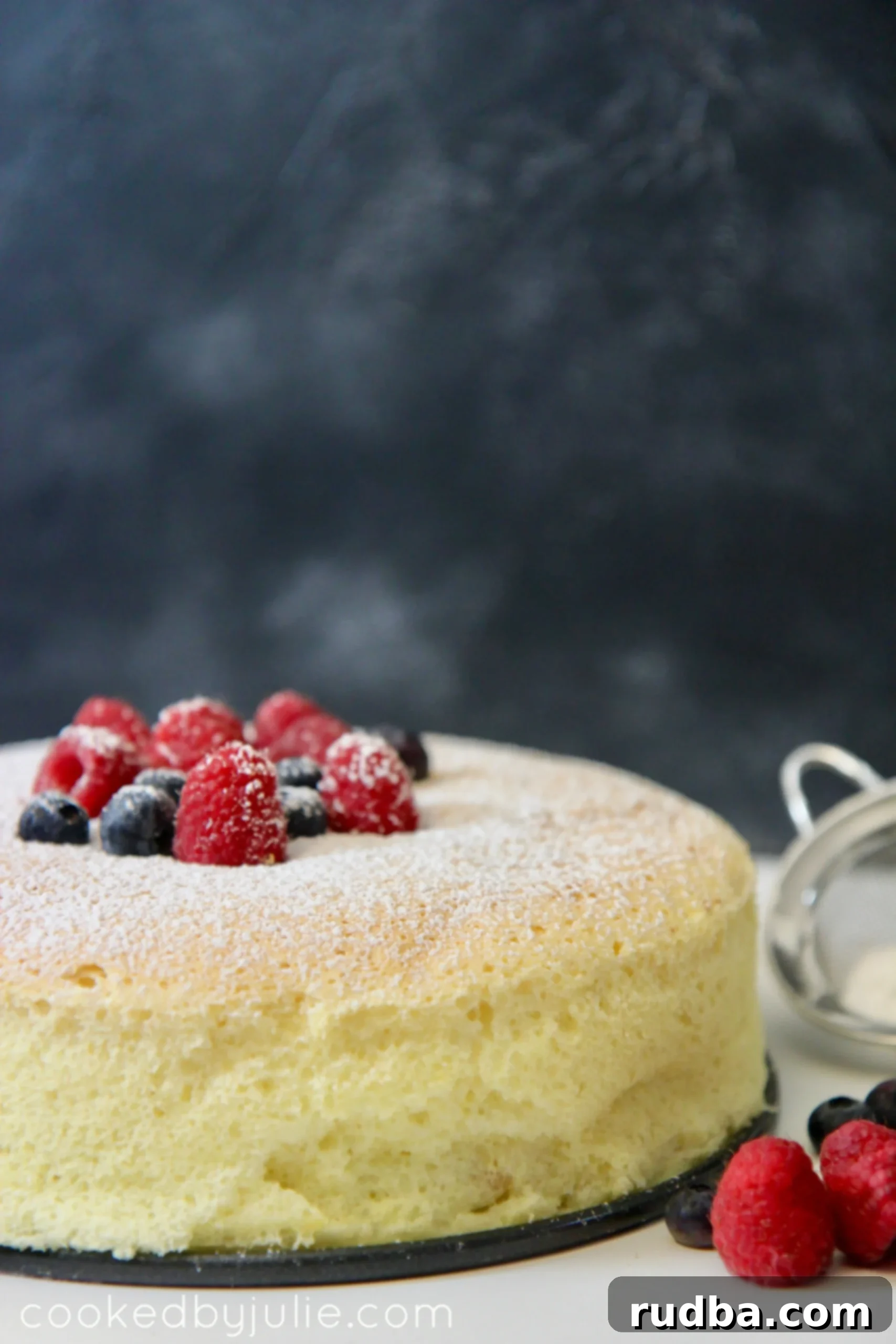
What Makes Japanese Cotton Cheesecake So Special?
At its core, Japanese Cotton Cheesecake is a unique fusion that takes the best elements of cheesecake and a soufflé. Imagine the creamy, slightly tangy essence of cream cheese blended with the lightness of expertly whipped egg whites, and you begin to grasp its magic. It’s truly a distinctive dessert that differs significantly from a traditional plain cheesecake, often surprising those accustomed to the dense, rich texture of New York-style versions.
Its moniker, “Cotton Cheesecake,” perfectly describes its incredibly tender and moist crumb that feels like soft cotton on the palate. Some also refer to it as “Soufflé Cheesecake” due to the meticulous folding of meringue, which gives it its characteristic airy rise and delicate structure. In Japan, it’s also sometimes called Hakata Cheesecake, or simply ‘jiggly cake’ because of its captivating wobble straight out of the oven.
Historically, this style of cheesecake gained significant popularity in Japan, notably influenced by baker Tomotaro Kuzuno in the 1960s who adapted a German recipe. It quickly became a beloved dessert, cherished for its subtle sweetness and incredible lightness, making it a perfect accompaniment to tea or coffee without being overly heavy.
What sets this recipe apart from many others is its relative simplicity despite the sophisticated result. While it requires attention to detail, particularly in handling the egg whites and baking process, the steps themselves are not overly complicated. My personal preference leans towards enjoying a slice cold, as it develops an even more refined texture, but the joy of being able to cut into this fluffy delight without a long refrigeration period is truly a game-changer.
The Secret Behind the Signature Texture: Key Ingredients and Techniques
Achieving the signature jiggly, light, and fluffy texture of a Japanese Cotton Cheesecake relies on a few critical ingredients and careful techniques. Understanding these elements will elevate your baking and help you master this delightful dessert.
The Role of Egg Whites: The Heart of the Soufflé
The voluminous height and incredible lightness come primarily from the egg whites. Separated from the yolks, these whites are whipped into a soft peak meringue with sugar and cream of tartar. The cream of tartar acts as a stabilizer, ensuring the meringue holds its structure. The key is to achieve soft peaks – stiff peaks can make the cake dry and prone to cracking. This airy meringue is then gently folded into the cream cheese batter, carefully incorporating air without deflating it.
Cream Cheese, Butter, and Milk Base: The Flavorful Foundation
Unlike traditional cheesecakes that use cream cheese straight from the package, this recipe starts by gently melting cream cheese, butter, and milk in a saucepan. This process creates an incredibly smooth, lump-free, and homogenous base, which is crucial for the cheesecake’s silky texture. Allowing this mixture to cool completely before adding the egg yolks prevents the yolks from cooking prematurely, ensuring a consistent batter.
The Water Bath (Bain-Marie) Method: Gentle Baking for Perfection
The use of a water bath, or bain-marie, is non-negotiable for a perfectly baked Japanese Cotton Cheesecake. Placing the springform pan into a larger oven-safe skillet filled with boiling water ensures that the cheesecake bakes slowly and evenly. The steam from the water bath creates a humid environment in the oven, preventing the edges from drying out and cracking, promoting a smooth top, and contributing to the incredibly moist, custard-like interior. This gentle baking method is vital for its characteristic texture.
The Perfect Oven Temperature: A Dance of Heat
Precision in oven temperature is another crucial factor. This recipe typically calls for an initial bake at a slightly higher temperature (e.g., 320°F / 160°C) to help the cheesecake rise beautifully, followed by a reduction in heat (e.g., 280°F / 135°C) for the majority of the baking time. This gradual reduction ensures that the cake cooks through gently without over-browning or developing a tough crust, allowing it to remain wonderfully light and soft.
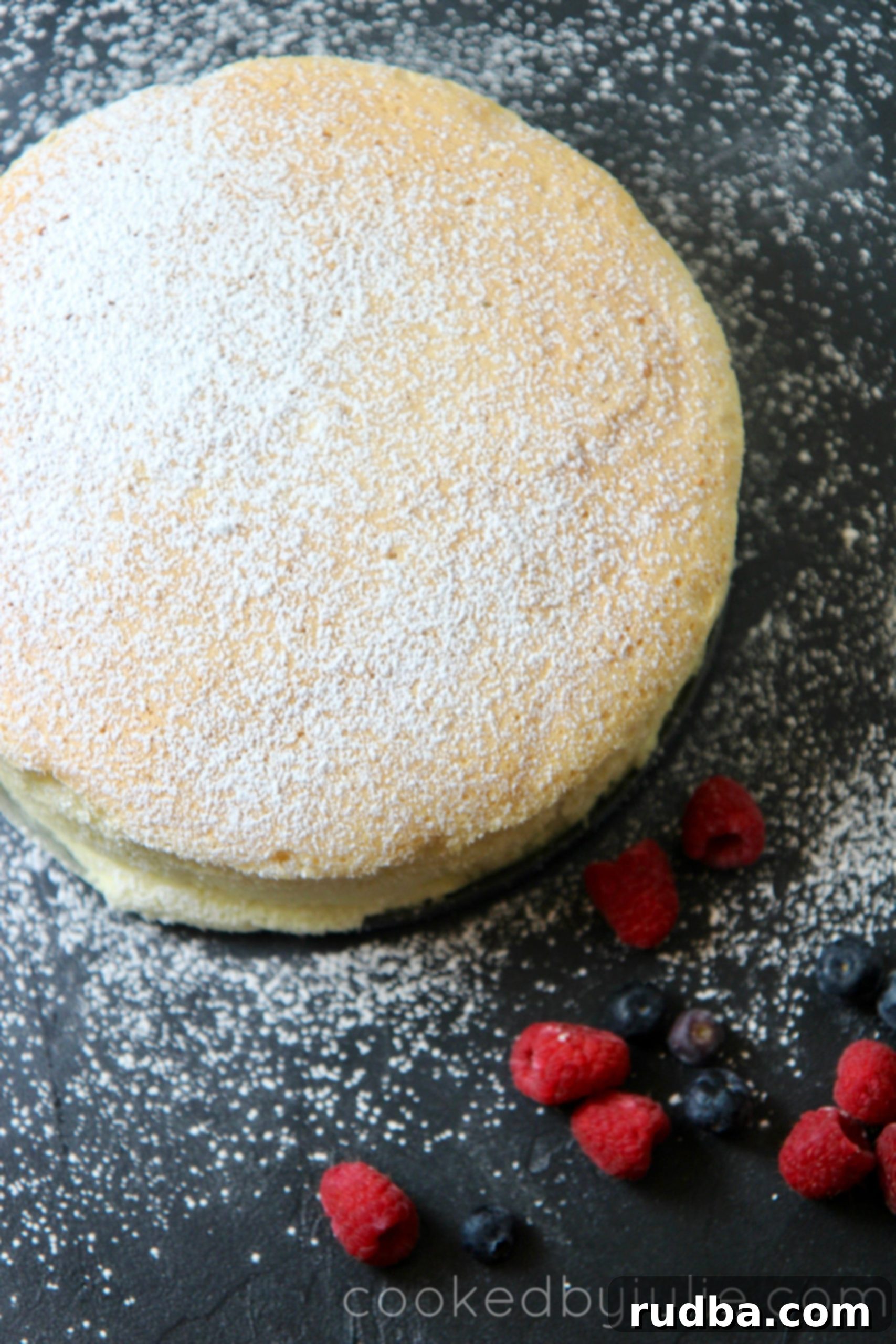
Is Japanese Cotton Cheesecake Hard to Make? (Spoiler: It’s Easier Than You Think!)
Many aspiring bakers are intimidated by the delicate nature of soufflés and cheesecakes, often wondering if a Japanese Cotton Cheesecake recipe is too challenging. The good news is, while it requires a methodical approach, it’s far from difficult. It’s more about precision and patience than complex techniques.
This particular recipe is designed to be super easy, making the process enjoyable and rewarding. The steps are clearly outlined, and by following them diligently, even novice bakers can achieve a show-stopping dessert. While some might find the separation of eggs and gentle folding “a bit tedious,” the overall process is simple and the end result is absolutely worth the effort. Plus, one of the biggest benefits of this specific recipe is that you don’t need to refrigerate it for four hours before enjoying a slice – you can dig in almost immediately after it cools slightly!
Perfect Pairings and Serving Suggestions for Your Fluffy Creation
The versatility of Japanese Cotton Cheesecake makes it a fantastic dessert for any occasion. Its delicate flavor profile pairs beautifully with a variety of toppings and accompaniments, allowing you to customize each serving.
For a classic presentation, a simple dusting of powdered sugar highlights the cake’s elegant simplicity, while a medley of fresh fruits adds a burst of color and natural sweetness. Consider vibrant berries like strawberries, raspberries, or blueberries, or perhaps a slice of kiwi or a few orange segments for a zesty contrast.
Beyond fresh fruit, the possibilities are endless. A dollop of lightly sweetened whipped cream can enhance its creamy texture. For those who enjoy a richer finish, a drizzle of fruit compote, such as a raspberry coulis or a warm cherry sauce, works wonderfully. A touch of caramel sauce or a light chocolate ganache could also add an extra layer of decadence without overpowering the cheesecake’s subtle charm.
As mentioned, this cake is delicious both warm and cold. Eating it warm highlights its soufflé-like qualities, offering a comforting, melt-in-your-mouth experience. When chilled, the texture becomes slightly firmer yet still incredibly soft and creamy, often developing a more pronounced tang from the cream cheese. Serve it with a scoop of premium vanilla ice cream for an indulgent treat that balances warm and cold sensations.
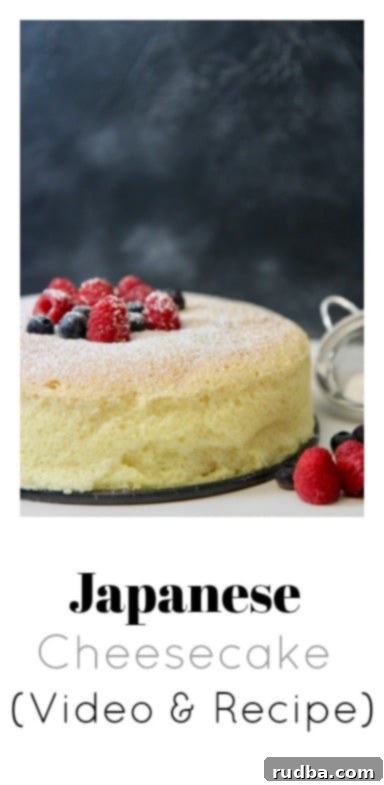
Troubleshooting Common Japanese Cheesecake Challenges
Even with a straightforward recipe, baking can sometimes present challenges. Here are a few common issues you might encounter with Japanese Cotton Cheesecake and how to address them:
Why did my cheesecake crack?
Cracking is a common issue, often due to sudden temperature changes or baking at too high a temperature. Ensure your oven temperature is accurate, and resist the urge to open the oven door during baking, especially in the first hour. The water bath helps mitigate this, but sudden cool drafts can still cause cracks. Allow the cheesecake to cool slowly in the oven with the door ajar after baking to prevent thermal shock.
Why did my cheesecake sink?
A sunken cheesecake can be caused by over-mixing the egg whites (creating an unstable meringue), underbaking, or again, sudden temperature changes. Ensure your egg whites are whipped to soft peaks, not stiff, and fold them gently. Always make sure the cake is fully cooked by checking for a golden brown top and a slight wobble in the center when gently shaken.
Not as fluffy as I expected?
If your cheesecake isn’t as fluffy as desired, it might be due to deflating the egg whites during folding. The folding technique is crucial: gently incorporate the meringue into the cream cheese mixture in stages, using a spatula to cut through the center and fold the batter over, preserving as much air as possible. Also, ensure your egg whites are free of any yolk contamination, as fat prevents them from whipping properly.
Other Delicious Cheesecakes You Must Try
If you’ve fallen in love with the art of cheesecake making, or simply adore this versatile dessert, here are some other incredible recipes to expand your baking repertoire:
- Pumpkin Cognac Cheesecake
- Nutella Cheesecake
- Salted Caramel Cheesecake
- Funfetti Cheesecake
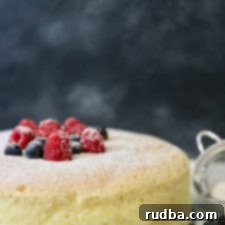
Japanese Cotton Cheesecake
Save RecipeSaved Recipe
Pin Recipe
Rate Recipe
Print Recipe
Ingredients
- 4 ounces unsalted butter
- 2/3 cup milk
- 8 ounces cream cheese
- 12 egg whites
- 8 egg yolks
- 1 tbsp vanilla
- 1/2 cup flour
- 1/2 cup cornstarch
- 2/3 cup sugar
- 1/4 tsp cream of tartar
Instructions
-
Preheat oven to 320 degrees F.
-
Sift the corn starch and flour, set aside.
-
Line the bottom and sides of an 8-inch springform pan with parchment paper. Wrap the outside of the springform with aluminum foil, set aside.
-
In a saucepan add the cream cheese, butter, and milk. Cook over medium-low heat until melted and completely smooth. Allow it to cool completely.
-
In the bowl of a standing mixer, whisk the egg whites, cream of tartar, and sugar until soft peaks.
-
Add the egg yolks to the cooled cream cheese mixture and whisk until pale.
-
Add the vanilla extract, cornstarch, and flour to the egg yolk mixture.
-
Fold 1/2 cup at a time of the egg white mixture into the yolk and cream cheese mixture until it is all incorporated.
-
Place the mixture into the prepared springform pan.
-
Place the springform pan in a large oven-safe skillet with high sides.
-
Pour boiling hot water around the sides of the skillet until it reaches halfway up.
-
Bake the cheesecake for 20 minutes.
-
Reduce the heat to 280 degrees F and cook for an additional hour and 20 minutes or until the top is golden brown.
-
Serve warm or cold and enjoy with fresh fruit and powdered sugar, if desired.
Video
Notes
Nutrition
Nutrition information is automatically calculated, so should only be used as an approximation.
Additional Info
Like this recipe? Leave a comment below!
Mastering the Japanese Cotton Cheesecake is a rewarding experience that brings a unique and delightful dessert to your table. Its unparalleled fluffiness, delicate flavor, and jiggly texture make it a standout choice for any dessert lover. With this detailed guide and straightforward recipe, you’re well on your way to creating a culinary masterpiece that will impress everyone. Don’t hesitate to dive into this recipe; your taste buds will thank you!
